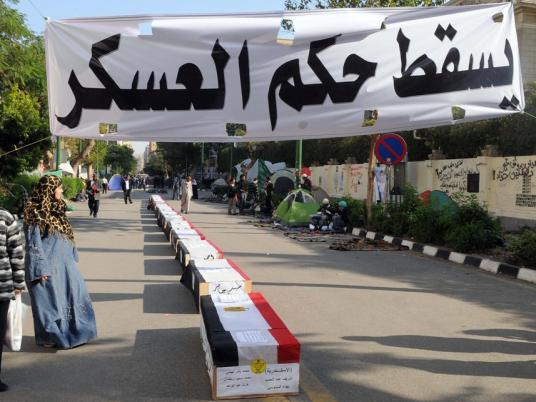
With the new government sworn in, 200 protesters continue their sit-in outside the cabinet building. They have various demands, but two common motives: anger towards the ruling military council and rejection of its newly appointed government led by Prime Minister Kamal al-Ganzouri, who hails from the Mubarak era.
After Ganzouri’s appointment on 24 November, Tahrir protesters, who have been staging a sit-in in the square for almost three weeks, took their grievances to the cabinet building. Not only do they oppose the ruling council and Ganzouri’s appointment, but they also seek to empty Tahrir of protesters in order to allow traffic to return to normal and avoid alienating ordinary Egyptians.
“We moved here because the military council succeeded in dividing the Egyptian people. It was like Tahrir is a different country,” says Sharif Abdel Moneim, member of the Youth for Justice and Freedom Movement, who is taking part in the sit-in.
Some of those outside the cabinet building were injured in the revolution. Their violent dispersal, along with their families, from the square on 19 November mobilized tens of thousands to join the sit-in.
Such protesters are uninterested in the message conveyed by the big banner at the entrance of the sit-in calling for an end to military rule. They want medical care and employment for the revolution’s injured, who, despite the announcement of a state fund to support them, deny having received any help up to now.
“We are waiting for Ganzouri to tell us something that will bring us some relief; we’re not asking for the impossible,” says Gamal Abdel Aziz, a shop owner, who took part in the sit-in with his son Ahmed. Ahmed was shot in the foot when the Tahrir sit-in was attacked on 9 April.
In front of the cabinet, coffins representing the 44 martyrs who fell in the November clashes line the street.
“Look at this casket behind you. Today, it has the name of Bahaa al-Senousy on it, tomorrow it could have mine,” says Mohamed Fares, an activist participating in the sit-in. He pointed to the symbolic display, which was made in tribute to an Alexandrian activist who was shot dead in front of the offices of the Somouha Security Directorate on 20 November.
Despite their small number, those taking part in the cabinet sit-in appear well organized. Fares is one of three spokespersons the protesters have elected to speak on their behalf.
While some organized groups — such as the April 6 Youth Movement, the Youth for Justice and Freedom, and the Revolutionary Socialists — are participating in the protest, it is mostly sustained by people who are either seeking individual rights, or pushing for a political demand they feel has been abandoned by organized political forces: namely, the military’s removal from political power.
As the newly appointed prime minister affirms that he intends to enter his office following the swearing-in ceremony for new ministers, some protesters say they do not aim at keeping the prime minister out. Others are resolved not to let him through.
“The only way that Ganzouri is going to get into his office is on a military truck after it runs over us all,” says Fares.




